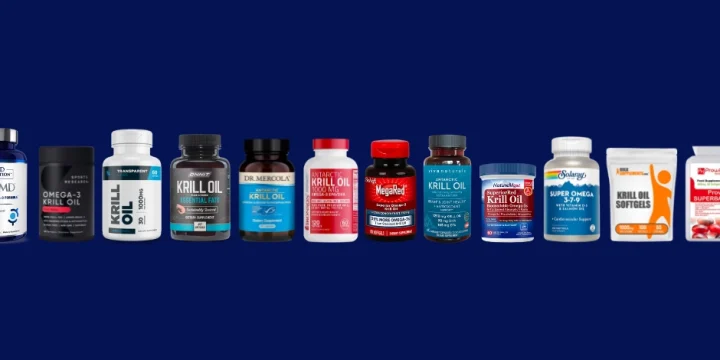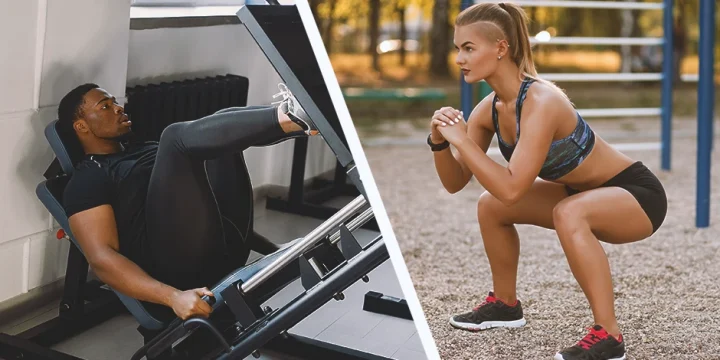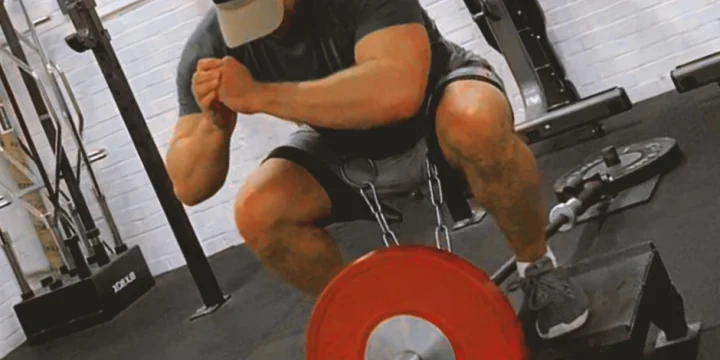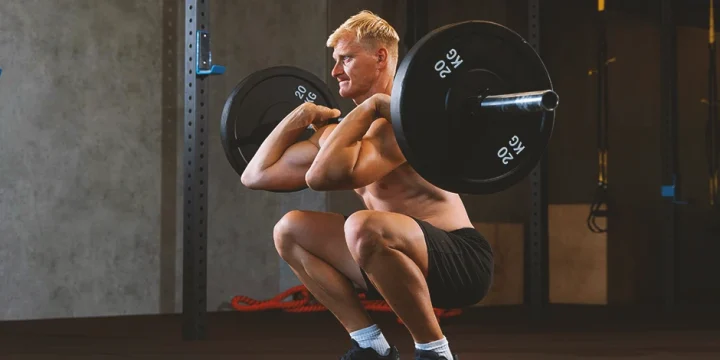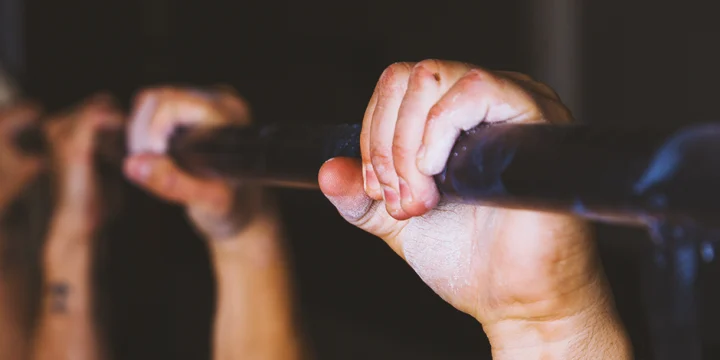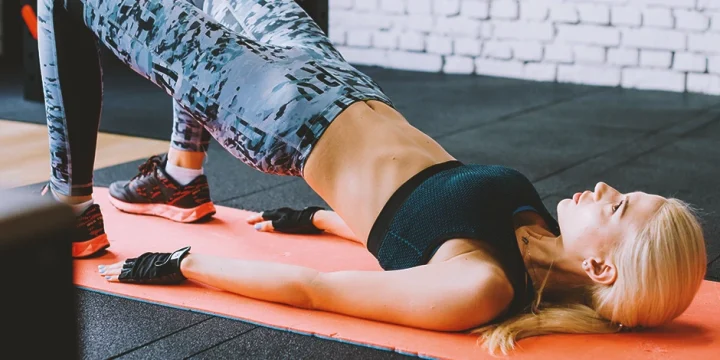I love adding kettlebell training to both cardio and strength workout plans, and as a personal fitness coach, I’ve seen people make huge improvements with goblet squats.
The problem is that the setup can make it easy to mess up the proper form.
But if you avoid some simple mistakes, then this is a great exercise for good posture.
So, our team got together with a physiotherapist to come up with the best possible instructions for you to follow.
We also added some variations for you to try out.
Quick Summary
- To perform the goblet squat, stand with feet shoulder-width apart, hold a kettlebell at chest height with palms on each side, squat deeply while maintaining a neutral spine, then rise to start.
- This exercise, ideal for intermediate workouts, targets the quadriceps, hamstrings, and glutes, while also engaging upper back and shoulder muscles.
- According to the National Institute of Health, goblet squats improve hip mobility by facilitating a deeper squat without the balance challenges of a barbell.
- In my opinion, the crush grip goblet squat is a versatile and effective exercise for those seeking a full-body workout with a focus on lower body strength.
How To Do A Crush Grip Goblet Squat Correctly

Here are the steps to follow in order to get this version of the goblet squat right:
- Stand with an upright posture and a foot position that is slightly wider than shoulder-width.
- Hold the kettlebell at chest height with the palm of each hand on each side of the ball with the handle pointing down.
- Try to avoid the fingers making contact with the kettlebell and push your hands together like you’re crushing the ball (hence the name of the exercise).
- Lean your torso forward slightly and start bending your knees until you get into a low squat position.
- Make sure you keep a neutral spine alignment for the entire movement to avoid common back injuries.
- Push your body back up to the starting position to complete one rep of the goblet squat.
- Aim for 6-10 reps to build muscle and more reps if you’re trying to lose a few pounds.
Also Read: Powerful Grip Strengthening Exercises
What Are The Benefits?

In my years of experience, I've noticed that goblet squats are a full-body exercise that comes with some great benefits for your fitness.
Improved Hip Mobility
One of the things this workout helps with is allowing people to get into a deep squat without having to worry about balancing a barbell.
And because you’re not dealing with more weight pushing down, according to the National Institute of Health (NIH), it can be easier to get down low to improve the range of motion in your hips, knees, and ankles [1].
Stronger Posture
With this unique kettlebell grip, you also force muscle groups in your back to fully engage, which, according to NIH, can have an excellent effect on your posture while sitting and doing other workouts [2].
You’re essentially building a stronger foundation that will help you lift more and avoid common injuries due to a weak core.
“Squats are a multi-joint, compound exercise that targets all the major muscles of the lower body, including the hips, glutes, and thighs.”
- Tara Laferrara, Certified NASM Personal Trainer
Enhanced Lower Body Strength
Goblet squats primarily target the quadriceps, hamstrings, and glutes, effectively building lower body strength.
The upright position of the goblet squat also engages the core, contributing to overall stability and balance, which is essential for athletic performance and daily activities.
Versatility and Scalability
Goblet squats are versatile and can be scaled to fit various fitness levels.
They can be performed with different weights, making them suitable for both strength building and endurance training.
This exercise can be easily incorporated into a wide range of workout routines, from bodyweight circuits to weighted strength sessions.
Avoid Mistakes

Similar to the barbell back squat, I consistently highlight to my clients the importance of avoiding certain common mistakes when performing a goblet squat.
Rounded Back
One of the most common problems I have seen with any kind of squat variation is that people tend to round out their upper or lower back during the movement.
According to NIH, this transfers a lot of pressure onto the disks in the back and can lead to severe pain and nerve damage [3].
Lifting Heels
Another common mistake I’ve seen people make is lifting their heels and transferring weight to the balls of the feet.
This could add unnecessary strain to your ankles and make keeping your balance more difficult.
One way to train yourself to avoid this is to use a resistance band instead.
Basically, stand your heels on the band, and if they come off the ground, the band will release.
You May Also Like:
Neglecting Core Engagement
Failing to engage the core during a goblet squat can lead to poor form and reduced effectiveness.
It's crucial to keep the core tight throughout the movement to maintain balance, support the spine, and maximize the exercise's benefits for the lower body and core strength.
Leaning Forward
Leaning too far forward shifts the weight onto the toes, which can strain the knees and reduce engagement of the target muscles.
Keeping the weight on the heels and the torso upright ensures proper alignment and maximizes the engagement of the glutes and hamstrings.
Goblet Squat Variations
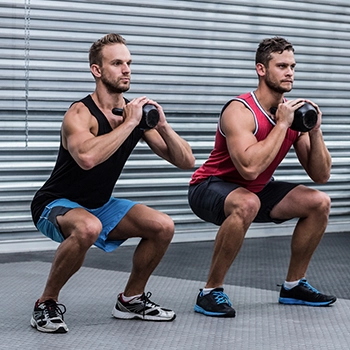
Here are some variations to the kettlebell goblet squat that can create an additional challenge.
To make it tougher on your upper body, you can either lift the kettlebell up over your head at the top of the movement or you can do what I call double bells.
That means holding a kettlebell in each hand rather than just one.
And to take this one step further, hold the bottom of the kettlebell up to force your hands and forearms to better balance them.
FAQs
What Muscles Does Crush Grip Goblet Squat Work?
Crush grip goblet squats work muscles in your legs, core, and back. The unique hand position, when done right, should engage muscles in your shoulders and back that you normally don’t get with a regular goblet squat.
What Are The Benefits Of Crush Grip Exercises?
The benefit of crush grip exercises is that they force the upper arms, shoulders, and back to support the grip. A normal hand grip would result in most of the support coming from the hand and forearm muscles.
References:
- https://www.ncbi.nlm.nih.gov/pmc/articles/PMC7276781/
- https://www.ncbi.nlm.nih.gov/pmc/articles/PMC4499985/
- https://www.ncbi.nlm.nih.gov/pmc/articles/PMC5117021/
About The Author
You May Also Like
